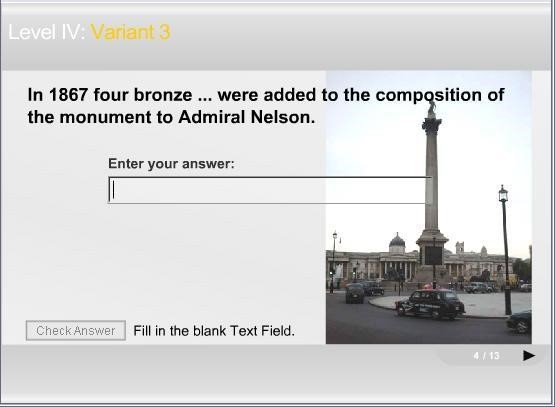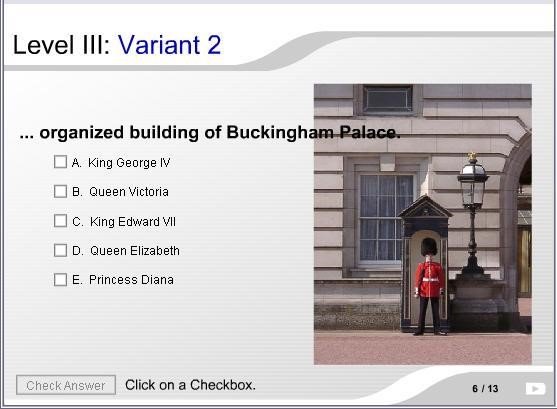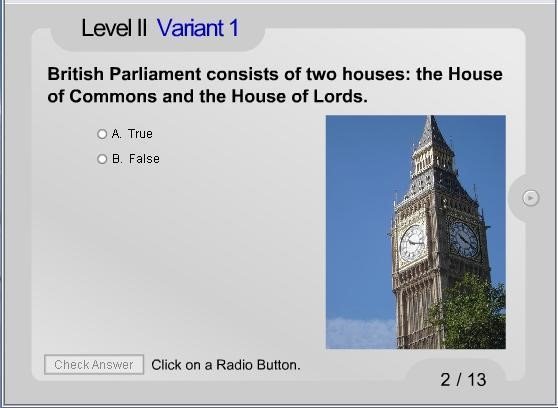План-конспект уроку з англiйської мови у 8 класі "Подорожуючи Лондоном" (з використанням програмних засобів навчального призначення)
План-конспект уроку з англiйської мови у 8 класі
(з використанням програмних засобів навчального призначення) Вчитель Черненко В.О.
Тип уроку: комбiнований
Тема: Подорожуючи Лондоном
Мета: навчально-комунiкативна: повторити вивчену лексику по даній темi та ознайомити учнiв з новими фактами, актуалiзувати наявнi знання по вказанiй темi та надати учням можливiсть надбати нову iнформацiю. виховна: прищепити iнерес до вивчення англiйської мови, цiкавiсть до традицій та звичаїв країни, мова якої вивчається.
розвиваюча: розвинути зорову та слухову пам'ять, довiльну увагу, фонематичний та iнтонацiйний слух, логiчне мислення, мовну здогадку, тренувати навичку дiалогiчного та монологiчного мовлення, читання, письма.
Обладнання: підручник О.Карп’юк, електронний підручник „Touring London”(слайдшоу екскурсій по найбільш відомим визначним місцям Лондону, електронний лист з Лондону, різнорівневі та багатоваріантні тести, тексти екскурсій), таблиці для складання програми екскурсій по столиці Великої Британії.
Хiд уроку:
I. Органiзацiйний момент. Привiтання. Виявлення чергових та вiдсутнiх.
II. Актуалiзацiя вивченого матерiалу.
Бесіда по матеріалу попереднього уроку (Лондон): -What was the topic of the previous lesson?
- What is the population of London?
- Where is it situated?
- What kind of city is London?
- What are the most important parts of London?
- What is the City of London?
- What is the West End?
- Who lives in the East End?
- What is Westminster Abbey?
- What great people are buried there?
III. Мотивацiя навчальної дiяльностi. Повiдомлення мети та теми уроку.
Teacher: So, we’re going to find out little more about some places of interest in London. You may ask me why? Today I’ll work not as a teacher, but as a representative of one of travel agencies “Touring London”. We organize excursions around the capital of Great Britain. But recently I’ve seen the letter from one of our manager’s sister that makes me think about the steps to improve our business. Why? Let’s have a look at the letter first.
Open the section “Letter” in your e-books. I’ll need your help because some parts of information have been damaged by a virus.
(Вчитель: Отже, ми збираємося взнати трохи більше про деякі визначні місця Лондону. Ви можете запитати мене «Чому?». Сьогодні я буду працювати не як вчитель, а як представник однієї з туристичних агенцій, що зветься «ПОДОРОЖУЮЧИ ЛОНДОНОМ». Ми організовуємо різні екскурсії по столиці Великої Британії. Але нещодавно я побачив листа від сестри одного з наших менеджерів, яке змусило замислитися над шляхами вдосконалення нашого бізнесу. З якої причини? Давайте, спочатку, поглянемо на листа. Відкрийте розділ «Лист» у ваших електронних підручниках. Мені буде потрібна ваша допомога, оскільки деякі частини листа були пошкоджені вірусом.)
IV. Фонетична зарядка. Проводиться з опорою на електронний лист. Один з „менеджерів” зачитує лист, учні слідкують й намагаються вголос відтворити назви визначних місць, „пошкоджені вірусом”.
Dear Vlad!
Thank you for your previous letter! I could not answer at once because I have been to
London as a tourist. My visit lasted only two days and there was too little time to see all places of interest in London. It was so difficult to decide what sights should be seen first of all.
I started with Sterminwest Beyab and was greatly surprised with the beauty of this old building. The Lapace of Sterminwest is situated two steps away from it. I took some photos at the Mathes River near this building. Then I took the bus to Garfaltra Resqua to see of the most famous monuments in London. Another square visited by me was Lydilcapic Cuscir.
There are dozens of museums in London but I managed to visit only the Tishbri Seummu. In the afternoon I went to The Werto of Donlon, this great fortress. Unfortunately it was too late to watch the Changing of the Guard at Hamingbuck Lacepa. As far as you can see in the photo I got to Werto Dgebri when it was getting dark. I enjoyed my visit to London greatly but some of my friends said there were so many places I had not visited and sights I had not seen.
Sincerely yours, Helen.
V. Мовна зарядка. Анкетні запитання про поїздку до Лондону.
I want you help the managers of our company make the best tour around London. Before we start our activity I have to ask you some standard questions.
- Have you ever been to London?
- Why would you like to go there?
- What sights would you visit there?
VІ. Вивчення нового матеріалу. Перегляд віртуальних екскурсій по Лондону та аудіювання повідомлень „менеджерів” туристичної компаніЇ.
To make the list of places of interest you should have some information. That’s why the managers of our company will show you some virtual excursions around London. Click the part of your e-book called “Excursions”. Lets start with …
1. Trafalgar Square
1. This famous square is so named in honour of Britain's victory over combined French and Spanish fleets at cape Trafalgar in 1805.
2. The national hero of this battle was Lord Horatio Nelson, admiral of the British fleet.
3. The Nelson Column was erected in 1842.
4. The column stands in the geographical centre of the city.
5. The column is 170 feet high with a 17 feet statue of Nelson on top.
6. The bronze reliefs on sides of the pedestal display four battles won by Nelson.
7. Admiral Nelson lost an eye in one battle, an arm— in another, a leg — in the third, and his life in Trafalgar.
8. His laconic command "England expects every man to do his duty" is carved in the granite on the southern side of the pedestal.
9. The monument is a replica of one of the Corinthian columns in the Temple of Mars at Rome.
9. The four bronze lions were modelled by Sir Edwin Landseer and cast by Marocchetti. They were added to the composition in 1867.
10. When the sculptures were unveiled they were described as being badly modelled, badly cast and like cats.
11. But, a hundred years later, the lions are still there.
12. Nowadays it is one of the best open air platforms for public meetings and demonstrations.
13. The square makes a good place for people to meet sightseeing buses pick up groups of visitors.
14. On New Year's Eve crowds gather around the tree and the lions to herald in the New Year.
15. The north side of the square is formed by the National Gallery.
16. It has the national collection of art and the world's greatest paintings.
17. The square is popular with visitors who come to relax, eat lunch and feed the pigeons.
2. The Palace of Westminster
1. The Palace of Westminster houses the British Parliament: the House of Lords and the House of Commons.
2. Documented history of the building goes back to the time when Westminster was still a marsh.
3. The first palace was built for Edward the Confessor, who came to the throne in 1042.
4. It was situated beside the Thames and next door to Westminster Abbey two miles away from the City.
5. Henry III added the Painted Chamber in the 13th century and in his reign Parliament (from French parler — to speak or talk) had its origins.
6. The Palace of Westminster was destroyed by the fire in 1834.
7. Sir Charles Barry received the commission to build the palace anew, in Gothic style.
8. Big Ben, the voice of London, has been telling the time to the city since 1859.
9. Construction of the 320 foot clock tower began in the year Queen Victoria came to the throne, 1837.
10. Clock designer, Sir Edmund Grimthorpe, the architect and clockmaker all died before the 13 1/2 ton bell was put behind the four clock faces.
12. The Great Bell cracked, was recast and cracked again, giving us the famous resonating boom.
13. Why Big Ben? There are some answers. May be it was named after Sir Benjamin Hall, the manager of works at that time, and a very big and fat man.
14. The Palace of Westminster has two miles corridors and more than one thousand rooms.
It is one of the most famous sights of London.
3. Buckingham Palace
1. Buckingham Palace is the official residence of the Queen.
2. It was built in the 18th century. Today the Palace contains 600 rooms.
3. Buckingham Palace is also the busy administrative centre of the monarchy.
4. One can see the royal standard when the Queen is in residence.
5. There is the white marble Queen Victoria Memorial in front of the Palace.
6. The Queen and The Duke of Edinburgh live there with their close family.
7. The Palace and the garden are never open to the public.
8. Only persons who are invited to the Garden Parties or other formal ceremonies can enter.
9. King George IV wanted John Nash to be the architect for his stately new home.
10. The building included 500 massive blocks of Carrara marble and cost £ 700,000.
10. The works of art from the Royal collection are not represented in the rooms of Buckingham Palace.
11. Today the Queen and the Duke of Edinburgh have private rooms in the North Wing.
12. More than 50,000 people visit the Palace each year as guests to lunches, dinners and receptions.
13. During the summer, the Changing of the Guard takes place at the front of the Palace.
14. Since 1660, Household Troops have guarded the Queen and the Royal Palaces.
15. They consist of Foot Guards in full-dress uniform of red tunics and bearskins.
16. The New Guard marches to the Palace from Wellington Barracks with a Guards band.
17. The Changing of the Guard takes place at 11.30 every day and lasts about 45 minutes.
18. From here the Queen leaves on ceremonial duties.
19. They are the State Opening of Parliament and Trooping the Colour to mark her official birthday in June.
4. British Museum
1. The British Museum is really a history museum. It is one of the most famous museums in the world.
2. The British Museum occupying a splendid great building, in the neoclassical or Grecian style, was erected between 1823 and 1847.
3. The British Museum is officially described as the National Library and Museum of History, Archaeology, Art and Ethnography.
4. The British Museum contains the most important collections in Britain. It was founded in 1753 by a decision of the Parliament.
5. Of the 11 major departments into which the museum is divided, the most outstanding are the Assyrian and Babylonian, the Egyptian, and the Greek and Roman Antiquities.
6. One of the most popular exhibitions is the collection of sculptures from the Parthenon.
7. Sculptures and reliefs from Greece and Rome always attract many visitors. Some of the statues are more than 2,000 years old.
8. Traditionally the statues in ancient Greece were made of marble and some other minerals. 9. A room devoted to Egypt is especially popular. The mummies, the statues of Pharaohs and Sphinxes are of great interest to visitors.
10. There are also important ethnological collections, including objects from the Pacific islands, America and Africa.
11. There is a collection of medieval objects of art from all the countries of Europe as well as examples of architecture.
12. The British Museum is famous for its Library.
13. The British Museum Library is a reading-room, so books may not be taken away.
14. It is one of the largest libraries in the world. It contains 8 mln books and over 100,000 manuscripts.
15. More than 400 readers can work at the desk of its great Circular Reading Room.
5. Piccadilly
1. For centuries Piccadilly has been the heart of London’s rich West End.
2. Piccadilly is a fashionable shopping centre these days.
3. Every day many of cars and buses pass the famous central fountain.
4. There one can always see the statue of Eros, the Greek god of love, on the top of the column.
5. Eros, the figure of an archer with his bow, a sculpture made of aluminium by the architect Sir Alfred Gilbert.
6. It’s official name is Shaftesbury Memorial, to commemorate the Earl of Shaftesbury, a Victorian Philanthropist.
7. At night Piccadilly is flooded with light from the illuminated signs and advertisements.
8. Nowadays Piccadilly Circus is a place that on special holidays, a such as a
Coronation or the New Year’s Eve, as many as 50,000 people gathers there.
9. The name of the square came from a house that belonged to a tailor in the 17th century.
10. He became rich by making the high collars known as "piccadillies".
11. The tailor's name was Higgens. He built a grand house which he called Pickadilla Hall. So the name remained.
6. Westminster Abbey
1. Westminster Abbey is a fine Gothic building, which stands opposite the Houses of Parliament.
2. The oldest part of the building dates from the eighth century. It was a monastery called the West Minster.
3. In the 11th century Edward the Confessor after years spent in France founded a great Norman Abbey.
4. He couldn’t attend the church because he fell ill and died.
5. The next year a new king, William the Conqueror was crowned there on Christmas Day setting a precedent.
6. Westminster Abbey has been the setting for every monarch's coronation.
7. Since 1308 kings and queens have used the specially designed Coronation Chair.
8. So, the oaken Coronation Chair made in 1300 is used for coronation ceremonies even these days.
9. In 200 years Henry III pulled down the Norman Abbey and built the most French of all English Gothic churches.
10. It is higher than any other English church (103 feet) and much narrower.
11. The process of rebuilding lasted nearly 300 years.
12. The West towers were added in the middle of the eighteenth century.
13. The Abbey is of stone so wonderfully cut and sculptured that it seems unreal.
14. The Chapel of Henry VII contains an interesting collection of flags and standards.
15. The Abbey is famous for its stained glass.
16. The Abbey is sometimes compared with a mausoleum.
17. There are tombs and memorials of almost all English monarchs, many statesmen, famous scientists, writers and musicians.
18. There many of the greatest writers are buried: Charles Dickens, Rudyard Kipling and others.
19. William Shakespeare, Burns and Byron, Walter Scott are not buried there, but one can see their memorials.
VII. Закріплення вивченого матеріалу.
А) Перевірка розуміння почутого. Проходження диференційованих комп’ютерних тестів (різних за обраним рівнем компетенції учнів).



Б) Робота в групах. Складання проекту екскурсійного туру по столиці Великої
Британії (з опорою на таблиці) та захист його.
If you are ready come up to this table, take a picture and join one of the groups for discussing the best possible tour around London. At the end of this lesson you’ll have to make the presentation of your list of sights and the reasons for choosing them.
Presentation Card:
|
Buckingham Palace, Westminster Abbey, the Palace of Westminster, the Tower of London, Tower Bridge, Trafalgar Square, Piccadilly Circus, the British Museum, Madame Tussaud Museum of Waxworks, Hyde Park, St. Paul’s Cathedral, London Eye. |
||
|
№ |
Place of interest |
Reasons for choosing |
|
|
|
|
VIIІ. Пояснення домашнього завдання.
Читати та переказувати текст „Екскурсія до Лондону”
Письмово – скласти питання для отримання додаткової інформації про екскурсію
Підготувати розповідь про свою уявну екскурсію до Лондону* (високий рівень)
IX. Визначення досягнутого рiвня компетенції учнiв та мотивацiя оцiнювання.
X. Пiдведення пiдсумку уроку.


про публікацію авторської розробки
Додати розробку
